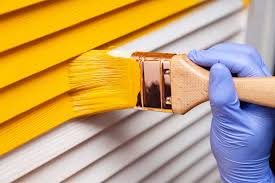The Difference Between Interior and Exterior Paints

Strong 8k brings an ultra-HD IPTV experience to your living room and your pocket.
When it comes to painting your home, one of the most crucial decisions you'll face is whether to use interior or exterior paint. These two types of paints are designed for different applications and offer distinct benefits, making it important to choose the right one for your project. Professional painters Vancouver, BC, can help guide you through this process to ensure the best results. In this article, we will explore the differences between interior and exterior paints, including their formulation, durability, and intended use.
1. Understanding Interior Paints
Interior paints are specially designed for use inside your home. They are formulated to provide a smooth, attractive finish that enhances the look of walls, ceilings, trim, and other interior surfaces. Here's a closer look at the features of interior paints:
Composition and Finish: Interior paints often have a smooth, low-sheen finish that works well in controlled indoor environments. They are less resistant to moisture, making them ideal for dry areas like living rooms and bedrooms.
Air Quality Considerations: These paints tend to have lower levels of volatile organic compounds (VOCs), which helps improve indoor air quality.
Durability: While interior paints are resistant to daily wear and tear, they aren't designed to withstand harsh conditions like outdoor weather.
Color Retention: Interior paints are available in a wide range of colors and finishes, allowing you to choose the perfect shade for your space.
2. Exploring Exterior Paints
Exterior paints are formulated to withstand the demanding conditions that outdoor environments can throw at them. From rain and snow to intense sunlight and fluctuating temperatures, exterior paints are built to handle the elements. Here’s what makes exterior paints different:
Composition and Finish: Exterior paints are often thicker and more durable than interior paints. They have a more robust finish that helps protect surfaces from water damage and mildew growth.
Weather Resistance: These paints are designed to withstand exposure to moisture, UV rays, and extreme temperatures. They typically contain additives that help prevent fading, peeling, or cracking.
Durability: The formulation of exterior paints is focused on long-lasting performance in outdoor conditions. They are made to endure the natural wear and tear of the outdoors, from rain to sun exposure.
Surface Variety: Exterior paints can be used on a variety of materials such as wood, stucco, brick, and metal, providing flexibility for outdoor projects.
3. Key Differences Between Interior and Exterior Paints
Now that we've covered the basics of both interior and exterior paints, let’s take a look at some key differences that will help you choose the right one for your needs.
Durability: Exterior paints are generally more durable than interior paints due to their resistance to weather conditions and environmental factors.
Moisture Resistance: While interior paints can handle the occasional spill or splash, exterior paints are specifically designed to resist prolonged exposure to moisture and humidity.
Odor and VOCs: Interior paints often have low or zero VOCs to minimize indoor air pollution, while exterior paints may contain higher levels of VOCs due to their stronger odor and weather-resistant qualities.
Finish Options: Interior paints tend to have more decorative finishes, such as matte, satin, and gloss, while exterior paints are focused on durability and protection.
4. When to Choose Interior Paint
Interior paints are ideal for projects inside your home, such as painting walls, ceilings, and trim. These paints are designed to create a smooth, attractive finish in areas that are sheltered from harsh outdoor conditions. If you're in need of a quality finish for your living room, bedroom, or kitchen, interior paints are your go-to option.
5. When to Choose Exterior Paint
Exterior paints are the best choice for protecting surfaces exposed to outdoor elements. Whether you're painting the exterior of your house, fences, or decks, these paints are specially designed to stand up to sun, rain, wind, and temperature changes. If you want a long-lasting paint job for the exterior of your property, exterior paints should be your top pick.
Conclusion
In summary, choosing between interior and exterior paints depends largely on the environment and conditions the paint will be exposed to. Interior paints are designed for dry, controlled spaces, offering a smooth finish and a wide variety of colors. On the other hand, exterior paints are formulated to withstand harsh outdoor elements, offering superior durability and protection for outdoor surfaces.
If you're planning a painting project, be sure to consult with professional painters Vancouver, BC, who can help you select the best type of paint for your needs and ensure that your project is completed to perfection. Whether it's for your home’s interior or exterior, the right paint will make all the difference in achieving a lasting, beautiful finish.
Note: IndiBlogHub features both user-submitted and editorial content. We do not verify third-party contributions. Read our Disclaimer and Privacy Policyfor details.


